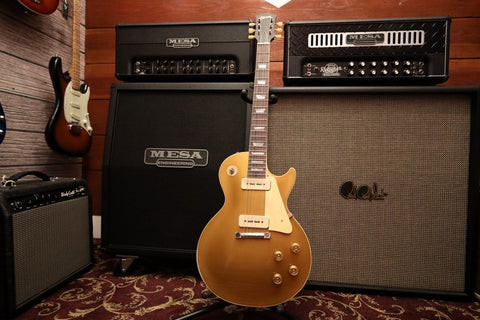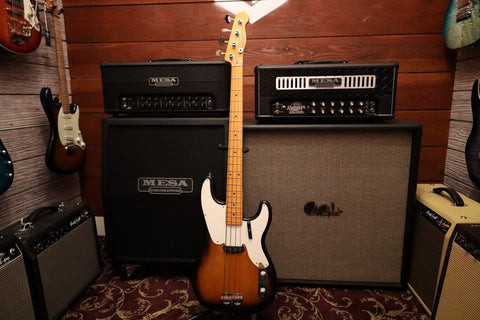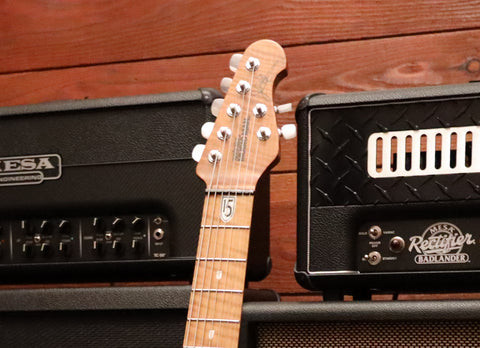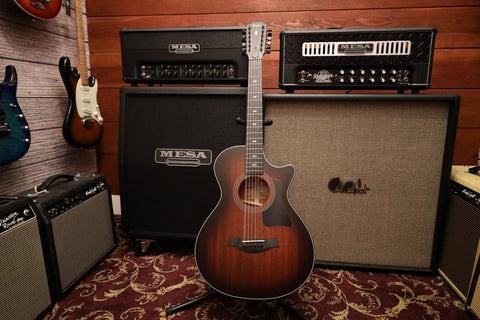The guitar stands as a timeless icon in the world of musical instruments, revered across cultures and genres for its expressive capabilities. At the heart of every guitar’s voice lie its strings. These seemingly simple strands of material are the very source of its rich sound, each one vibrating with potential to create diverse tones and melodies under the skilled touch of a musician. If you’ve ever wondered how many strings in a guitar are typical, or if there’s more to it than meets the eye, you’re about to embark on an enlightening journey.
While the image of a standard six-string guitar might immediately come to mind, the world of guitars is wonderfully diverse. The number of strings can vary significantly, each configuration offering unique sonic possibilities and catering to different musical styles. Let’s delve into the fascinating realm of guitar strings, exploring the standard setups and the intriguing variations that exist.
Understanding the Guitar: A Stringed Instrument
At its core, a guitar is classified as a stringed musical instrument. In its most common form, a guitar features six strings. These strings are typically crafted from either nylon or steel, materials chosen for their distinct tonal properties. Each string is tuned to a specific pitch, and together, they create a wide spectrum of musical notes. The magic happens when these strings are plucked or strummed, producing the melodies and harmonies that we associate with guitar music.
While six strings are the most prevalent, it’s important to know that guitars can come with a broader range of string configurations. You’ll find guitars with seven, eight, nine, twelve, and even more strings. These variations aren’t just for novelty; they serve specific musical purposes and are frequently employed in genres like jazz, metal, and classical music, where extended ranges and unique tonal textures are highly valued.
Types of Guitars and String Numbers
To truly understand the variations in string numbers, it’s helpful to explore the main types of guitars. Each type has evolved to serve different musical needs, and this evolution is reflected in their construction and, importantly, the number of strings they typically feature.
Acoustic Guitars
Acoustic guitars are celebrated for their natural, resonant sound, achieved through their hollow body construction. This design amplifies the vibrations of the strings, projecting the sound outwards without the need for electronic amplification. They are a staple in genres like folk, country, and pop music, prized for their warm and organic tone. Most acoustic guitars come with either six strings for standard playing or twelve strings, which offer a richer, chorus-like sound.
 Acoustic guitar close up showing the sound hole and strings
Acoustic guitar close up showing the sound hole and strings
Electric Guitars
Electric guitars take a different approach to sound production. They utilize metal strings, which are crucial for interacting with magnetic pickups. These pickups convert the string vibrations into electrical signals, which are then amplified to produce sound. Electric guitars often feature a solid body, contributing to their sustain and focused tone, making them the instrument of choice for genres like rock, metal, and blues. While six strings are standard, electric guitars are also commonly found with seven, eight, or even more strings, particularly in heavier genres.
Classical Guitars
Classical guitars are distinguished by their use of nylon strings, which produce a softer, warmer, and more mellow tone compared to steel strings. This characteristic sound is highly sought after in classical and flamenco music. The wider neck and flat fretboard are also designed to facilitate intricate fingerstyle playing. Classical guitars almost universally feature six strings.
 Close-up of a classical guitar headstock showing nylon strings and tuning pegs
Close-up of a classical guitar headstock showing nylon strings and tuning pegs
Bass Guitars
Bass guitars are designed to produce low-frequency sounds, providing the rhythmic and harmonic foundation in a wide range of musical styles. They typically have a longer neck and thicker strings than other types of guitars to achieve these lower tones. The most common configuration for bass guitars is four strings, although five and six-string versions are also prevalent, offering extended lower ranges.
Each of these guitar types demonstrates how the number of strings is closely linked to the instrument’s intended sound and musical application.
The Standard Six-String Guitar: Why It’s the Norm
When most people think of a guitar, the standard six-string guitar is what comes to mind. This configuration isn’t just a matter of chance or tradition; it’s a design that has proven incredibly versatile and musically effective over time, making it a cornerstone of music across countless genres. Let’s explore why the six-string setup has become so deeply ingrained in the music world.
Examining the Standard Six-String Guitar Layout
The standard six-string guitar, often referred to as the Spanish guitar, is typically tuned to the notes E, A, D, G, B, and E, progressing from the lowest (thickest) string to the highest (thinnest). This tuning arrangement has become the bedrock of much of modern music due to its remarkable ability to produce everything from deep bass lines and rich melodies to sparkling chords – all within a single instrument.
Why Six Strings Have Become the Norm in Most Musical Genres
The six-string guitar’s widespread adoption stems from its inherent versatility and balance. Here’s why it has become the standard:
- Wide Sonic Spectrum: Six strings effectively cover a broad range of pitches commonly used in Western music. This allows guitarists to explore both lower and higher register frequencies, making it a very adaptable instrument.
- Balance of Complexity and Playability: The six-string layout strikes a perfect balance between musical complexity and ease of playability. It’s accessible enough for beginners to learn on, yet offers enough depth for virtuoso musicians to explore a vast musical landscape.
- Universal Genre Appeal: From rock and blues to pop, country, folk, and classical music, the six-string guitar has been wholeheartedly embraced by a multitude of genres. This widespread adoption is a testament to its universal musical utility and appeal.
In essence, the six-string guitar’s enduring popularity rests on its optimal combination of musical range, playability, and cultural resonance, making it the quintessential guitar in our collective musical consciousness.
Exploring Variations in String Numbers
While the six-string guitar holds a central place, the world of guitars is far from monolithic. A fascinating aspect of guitar evolution is the development of variations in string numbers. These deviations from the standard six strings are not arbitrary; they are purposeful designs created to expand sonic possibilities and cater to the specialized needs of different musical styles and player preferences. As we delve into different guitar types with various string numbers, we uncover a spectrum of sounds and playing experiences.
Seven-String and Eight-String Guitars: Expanding the Range
For musicians seeking a broader tonal palette, seven-string guitars and eight-string guitars offer compelling options. The seven-string guitar typically adds a lower string tuned to B, extending the instrument’s bass range and enabling deeper, richer low-end notes. This addition has found considerable favor in genres like metal and jazz, where musicians often explore lower registers and require a more expansive sonic canvas.
Pushing the boundaries even further, eight-string guitars incorporate an additional low string, commonly tuned to F# or even E. This extended range becomes instrumental in creating complex, layered musical textures and is particularly valued in genres that demand a very wide array of pitches and deep, guttural tones.
 An eight-string electric guitar with a distinctive extended range neck
An eight-string electric guitar with a distinctive extended range neck
Twelve-String Guitars: Rich and Resonant
For those desiring a naturally lush and resonant sound, the twelve-string guitar is a captivating choice. Instead of single strings, it utilizes pairs of strings, known as courses. Each course consists of two strings played together, either in unison or an octave apart. This doubling effect creates a distinctive chorus-like shimmer and a significantly fuller, richer sound that is instantly recognizable in folk, rock, and various forms of popular music. However, the doubled strings require a more robust guitar construction to withstand the increased tension, and they can also present a greater playing challenge due to the increased string density.
Alternate Tunings: Changing the Pitch Landscape
Beyond the physical structure and number of strings, another significant aspect of guitar versatility lies in the realm of alternate tunings. Tuning, in essence, refers to the specific pitches assigned to each string, establishing the fundamental tonal framework for playing and composing music. By deviating from standard tuning, musicians can drastically transform a guitar’s sonic character, unlocking a wealth of creative possibilities.
The Role of Tuning in Stringed Instruments
Stringed instruments like the guitar are designed to resonate at specific frequencies. The tuning process is the act of aligning these resonant frequencies with desired musical notes, typically according to a standardized system. In standard tuning, the progression from lowest to highest string (E, A, D, G, B, E) creates a familiar and logical musical scale framework that guitarists readily utilize.
How Alternate Tunings Can Effectively Change the Number of Pitches Available
Alternate tunings empower guitarists to experiment with diverse sounds and playing techniques. By altering the pitch of one or more strings, players can explore:
- New Chord Voicings: Alternate tunings often create unique and interesting chord voicings that are not easily accessible in standard tuning.
- Extended Harmonic Ranges: Some tunings expand the overall range of the guitar, allowing access to lower or higher notes.
- Easier Access to Intervals and Scales: Certain tunings make it simpler to play specific intervals and scales, streamlining the playing process for certain musical styles.
- Open Chords: Some alternate tunings, known as open tunings, are configured so that strumming the open strings produces a complete chord without needing to fret any notes. This fundamentally changes the “landscape” of the guitar fretboard and opens up new sonic territories.
Common types of alternate tunings include:
- Dropped Tunings: These tunings lower the pitch of the lowest (typically 6th) string, most commonly to D (Drop D tuning). This facilitates playing power chords with simpler, one-finger barre shapes, popular in rock and metal.
- Open Tunings: Strings are tuned to create a major or minor chord when strummed open. Open G and Open D are popular examples, often used in blues, slide guitar, and folk music.
- Modal Tunings: Tunings designed to emphasize specific musical modes, providing unique melodic and harmonic flavors. DADGAD is a well-known modal tuning used in Celtic and folk music.
Each alternate tuning not only changes the available pitches but can also inspire different stylistic choices and songwriting approaches, enriching the guitarist’s creative toolkit.
Historical and Traditional Roots of String Numbers
The guitar, as we know it today, is the product of a long and fascinating history, shaped by diverse cultures and evolving musical preferences across time. This historical journey has profoundly influenced the number of strings commonly found on modern guitars. To understand why the six-string guitar became dominant, it’s essential to consider the instrument’s historical and traditional roots.
Insight into Historical and Traditional Variations
Looking back at the guitar’s ancestors – instruments like the lute, vihuela, and the earlier medieval gittern – we find a wide variety in string numbers. These early instruments typically ranged from four to as many as ten or more courses of strings. The emergence of the six-string guitar, often attributed to Spain in the 16th century, marked a significant turning point. Its versatility and richer harmonic possibilities led to its widespread adoption, eventually establishing it as the standard format.
The Evolution of String Use Across Different Cultures and Time Periods
Guitars and related stringed instruments have played pivotal roles in music-making worldwide, and their string arrangements reflect the cultural and musical aesthetics of their time and place of origin.
- European Influence: The 1700s witnessed the widespread acceptance of the sixth string in Europe, opening up a broader palette of tonal possibilities and contributing to the development of classical guitar repertoire.
- Middle Eastern Origins: Early plucked string instruments from the Middle East, often played with a plectrum, typically featured fewer strings. These instruments played a role in the evolution of early European stringed instruments.
- African and Asian Contributions: Instruments like the African kora, with its impressive array of up to 21 strings, and traditional Asian instruments such as the Chinese guqin, demonstrate that the development of stringed instruments is a global story, with diverse approaches to string numbers and configurations.
 A collection of historical guitars and lute-like instruments showcasing varied shapes and string arrangements
A collection of historical guitars and lute-like instruments showcasing varied shapes and string arrangements
Understanding the historical and traditional context of guitar string numbers not only illuminates the “why” behind the modern standard but also enriches our appreciation for the instrument’s diverse sonic heritage and ongoing evolution.
String Material and Construction: Impact on Sound
Guitar strings are not just passive components; they are active participants in shaping the instrument’s tone. Understanding how different string materials and construction methods influence sound production is crucial for guitarists seeking to optimize their instrument’s voice. Let’s explore the tonal contrast between metal and nylon strings and the broader impact of string material science on acoustic quality.
Metal vs. Nylon: A Tonality Contrast
The choice between metal and nylon strings is often dictated by musical style and the desired tonal character. Metal strings, typically made from steel or nickel alloys, produce a bright, articulate, and resonant tone. This makes them ideal for genres like rock, country, and folk, where a clear and projecting sound is often desired. The crispness of metal strings arises from their higher tension and tendency to vibrate at higher frequencies, producing pronounced harmonics.
Nylon strings, in contrast, are commonly found on classical and flamenco guitars. They are known for emitting a warmer, mellower, and more rounded sound. Their softer material and lower tension contribute to a nuanced tonal palette, emphasizing rich overtones and a gentler timbre, making them favored in classical music and traditional ballads.
Material Science: The Link Between String Materials and Acoustic Quality
The science of string materials goes beyond the basic metal versus nylon dichotomy. The specific alloys and composites used in string construction further refine the quality of sound. For example, phosphor bronze strings are popular among acoustic guitarists for their deep, warm tone and smooth feel, often described as having a “woody” character.
Coated strings represent a technological advancement that not only extends string lifespan but also subtly affects tonal brightness and sustain. Similarly, variations in string gauge, or thickness, have a significant impact on volume, sustain, and playability. Heavier gauges generally produce a fuller, louder sound with more sustain but may require more finger strength. Lighter gauges offer easier playability and a brighter tone, often preferred for faster playing styles.
In essence, the material and construction of guitar strings are fundamental elements that sculpt the instrument’s sonic personality and playing experience.
Guitar Genres and String Preferences
The world of guitars is beautifully mirrored in the diversity of music genres they inhabit. Across different styles of music, the number of strings on a guitar plays a significant role in shaping the sound and playability preferred by musicians. Different genres often gravitate towards specific guitar types, which, in turn, influences the typical string configurations players choose.
Classical and Flamenco
Classical and flamenco guitarists overwhelmingly favor the traditional six-string nylon-string guitar. This setup is perfectly suited for the intricate melodies, complex fingerpicking techniques, and warm tonal qualities that define these genres.
Rock and Metal
In the realms of rock and metal, guitarists often venture beyond the conventional six strings to achieve heavier, more expansive sounds. Seven-string guitars, popularized by artists like Steve Vai, offer an extended lower range, ideal for creating heavy riffs, detuned rhythms, and soaring solos. Eight-string guitars and beyond are also increasingly found in these genres, with musicians like Tosin Abasi pushing the boundaries of guitar music with their extended range instruments.
Jazz
Jazz guitarists, known for their sophisticated chord voicings and improvisational artistry, typically utilize six-string guitars. Legendary jazz figures like Wes Montgomery demonstrated the immense expressive potential of the six-string in the genre.
Country and Bluegrass
Country and bluegrass music often embrace the bright, twangy sound of the six-string steel-string acoustic guitar. Iconic musicians like Johnny Cash have cemented the six-string acoustic sound as a cornerstone of these genres.
Extended-Range Guitars
Extended-range guitars, encompassing seven, eight, or more strings, are gaining traction in experimental and progressive music genres. These guitars offer a broader sonic palette, enabling musicians to create novel and unique soundscapes.
- Seven-String Guitars: Favored in genres demanding heavy, aggressive tones and extended lower registers.
- Twelve-String Guitars: Common in folk and rock for their rich, natural chorus effect, as exemplified by artists like Roger McGuinn of The Byrds and Tom Scholz of BOSTON.
- Extended Range Bass Guitars: Used extensively in jazz fusion and progressive rock, these basses can have six or more strings to accommodate complex musical arrangements and bass lines.
Understanding these genre-specific string preferences can guide players in choosing the right number of strings to match their musical aspirations and desired sound.
Understanding Guitar Strings: A Harmonious Conclusion
Our exploration into the dynamic world of guitars reveals that the question of how many strings in a guitar has a multifaceted answer. The number of strings can vary widely, shaped by historical traditions, playing styles, and the ever-evolving quest for musical expression. From the standard six strings of a classical acoustic to the extended ranges of seven, eight, or twelve-string guitars, each configuration offers a distinct sonic landscape.
The guitar’s remarkable adaptability across genres is undeniable. This versatile instrument thrives in the hands of classical virtuosos, electrifying rock stars, improvisational jazz masters, and soulful folk musicians alike. Each type of guitar, with its specific string arrangement, contributes a unique flavor to the music it creates, underscoring the guitar’s incredible versatility.
Now, it’s your turn to explore the strings of possibility! Whether you are a beginner embarking on your musical journey or a seasoned player seeking new horizons, experimenting with different guitars and string numbers can lead to exciting sonic discoveries and expanded playing techniques.
- Feeling Inspired? Pick up a guitar, any guitar, and let its strings guide your musical exploration.
- Seeking Knowledge? Delve deeper into the world of guitar maintenance to ensure your instrument is always ready to play its best.
Take Your Guitar Journey Further
Continue your guitar education by exploring in-depth articles on each type of guitar and expanding your musical vocabulary with a detailed glossary of guitar terms. Armed with newfound knowledge and the right strings beneath your fingers, the next chapter of your guitar story is waiting to be strummed.
Stay curious, keep exploring, and let the resonant strings of the guitar amplify your musical spirit!
Share It:
[

